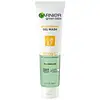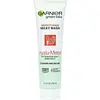What's inside
What's inside
 Key Ingredients
Key Ingredients

 Benefits
Benefits

 Concerns
Concerns

 Ingredients Side-by-side
Ingredients Side-by-side

Water
Skin ConditioningPropylene Glycol
HumectantPEG-30 Glyceryl Cocoate
EmulsifyingCapryl/Capramidopropyl Betaine
CleansingGlycerin
HumectantCocamidopropyl Betaine
CleansingDisodium Laureth Sulfosuccinate
CleansingAnanas Sativus Fruit Extract
Skin ConditioningAscorbyl Glucoside
AntioxidantTocopheryl Acetate
AntioxidantSodium Chloride
MaskingSodium Hydroxide
BufferingPhenoxyethanol
PreservativePEG-32
HumectantXanthan Gum
EmulsifyingBenzoic Acid
MaskingPropanediol
SolventPapain
Skin ConditioningGlycolic Acid
BufferingParfum
MaskingWater, Propylene Glycol, PEG-30 Glyceryl Cocoate, Capryl/Capramidopropyl Betaine, Glycerin, Cocamidopropyl Betaine, Disodium Laureth Sulfosuccinate, Ananas Sativus Fruit Extract, Ascorbyl Glucoside, Tocopheryl Acetate, Sodium Chloride, Sodium Hydroxide, Phenoxyethanol, PEG-32, Xanthan Gum, Benzoic Acid, Propanediol, Papain, Glycolic Acid, Parfum
Water
Skin ConditioningGlycerin
HumectantSodium Methyl Cocoyl Taurate
CleansingCoco-Betaine
CleansingSodium Cocoyl Isethionate
CleansingSodium Chloride
MaskingCitrullus Lanatus Fruit Extract
Skin ConditioningPEG-100 Stearate
PEG-30 Dipolyhydroxystearate
EmulsifyingPPG-5-Ceteth-20
EmulsifyingPEG-55 Propylene Glycol Oleate
Glyceryl Stearate
EmollientTrideceth-6
EmulsifyingSodium Hyaluronate
HumectantSodium Hydroxide
BufferingCoconut Acid
CleansingDisodium EDTA
Propylene Glycol
HumectantCaprylyl Glycol
EmollientPolyquaternium-53
Acrylates/C10-30 Alkyl Acrylate Crosspolymer
Emulsion StabilisingSalicylic Acid
MaskingPhenoxyethanol
PreservativeChlorphenesin
AntimicrobialParfum
MaskingWater, Glycerin, Sodium Methyl Cocoyl Taurate, Coco-Betaine, Sodium Cocoyl Isethionate, Sodium Chloride, Citrullus Lanatus Fruit Extract, PEG-100 Stearate, PEG-30 Dipolyhydroxystearate, PPG-5-Ceteth-20, PEG-55 Propylene Glycol Oleate, Glyceryl Stearate, Trideceth-6, Sodium Hyaluronate, Sodium Hydroxide, Coconut Acid, Disodium EDTA, Propylene Glycol, Caprylyl Glycol, Polyquaternium-53, Acrylates/C10-30 Alkyl Acrylate Crosspolymer, Salicylic Acid, Phenoxyethanol, Chlorphenesin, Parfum
Ingredients Explained
These ingredients are found in both products.
Ingredients higher up in an ingredient list are typically present in a larger amount.
Glycerin is already naturally found in your skin. It helps moisturize and protect your skin.
A study from 2016 found glycerin to be more effective as a humectant than AHAs and hyaluronic acid.
As a humectant, it helps the skin stay hydrated by pulling moisture to your skin. The low molecular weight of glycerin allows it to pull moisture into the deeper layers of your skin.
Hydrated skin improves your skin barrier; Your skin barrier helps protect against irritants and bacteria.
Glycerin has also been found to have antimicrobial and antiviral properties. Due to these properties, glycerin is often used in wound and burn treatments.
In cosmetics, glycerin is usually derived from plants such as soybean or palm. However, it can also be sourced from animals, such as tallow or animal fat.
This ingredient is organic, colorless, odorless, and non-toxic.
Glycerin is the name for this ingredient in American English. British English uses Glycerol/Glycerine.
Learn more about GlycerinParfum is a catch-all term for an ingredient or more that is used to give a scent to products.
Also called "fragrance", this ingredient can be a blend of hundreds of chemicals or plant oils. This means every product with "fragrance" or "parfum" in the ingredients list is a different mixture.
For instance, Habanolide is a proprietary trade name for a specific aroma chemical. When used as a fragrance ingredient in cosmetics, most aroma chemicals fall under the broad labeling category of “FRAGRANCE” or “PARFUM” according to EU and US regulations.
The term 'parfum' or 'fragrance' is not regulated in many countries. In many cases, it is up to the brand to define this term.
For instance, many brands choose to label themselves as "fragrance-free" because they are not using synthetic fragrances. However, their products may still contain ingredients such as essential oils that are considered a fragrance by INCI standards.
One example is Calendula flower extract. Calendula is an essential oil that still imparts a scent or 'fragrance'.
Depending on the blend, the ingredients in the mixture can cause allergies and sensitivities on the skin. Some ingredients that are known EU allergens include linalool and citronellol.
Parfum can also be used to mask or cover an unpleasant scent.
The bottom line is: not all fragrances/parfum/ingredients are created equally. If you are worried about fragrances, we recommend taking a closer look at an ingredient. And of course, we always recommend speaking with a professional.
Learn more about ParfumPhenoxyethanol is a preservative that has germicide, antimicrobial, and aromatic properties. Studies show that phenoxyethanol can prevent microbial growth. By itself, it has a scent that is similar to that of a rose.
It's often used in formulations along with Caprylyl Glycol to preserve the shelf life of products.
Propylene Glycol is an odorless, colorless liquid. As a humectant, it helps skin retain moisture. It also aids in delivering active ingredients.
Another role of this ingredient is preventing a product from melting or freezing. Propylene glycol also adds antimicrobrial properties to a product, elongating product lifespan.
This ingredient is considered an organic alcohol and commonly added into both cosmetics and foods.
Those with sensitive skin or conditions may develop a rash when using this ingredient.
Learn more about Propylene GlycolChances are, you eat sodium chloride every day. Sodium Chloride is also known as table salt.
This ingredient has many purposes in skincare: thickener, emulsifier, and exfoliator.
You'll most likely find this ingredient in cleansers where it is used to create a gel-like texture. As an emulsifier, it also prevents ingredients from separating.
There is much debate on whether this ingredient is comedogenic. The short answer - comedogenic ratings don't tell the whole story. Learn more about comegodenic ratings here.
The concensus about this ingredient causing acne seems to be divided. Research is needed to understand if this ingredient does cause acne.
Scrubs may use salt as the primary exfoliating ingredient.
Learn more about Sodium ChlorideSodium Hydroxide is also known as lye or caustic soda. It is used to adjust the pH of products; many ingredients require a specific pH to be effective.
In small amounts, sodium hydroxide is considered safe to use. However, large amounts may cause chemical burns due to its high alkaline.
Your skin has a natural pH and acid mantle. This acid mantle helps prevent harmful bacteria from breaking through. The acid mantle also helps keep your skin hydrated.
"Alkaline" refers to a high pH level. A low pH level would be considered acidic.
Learn more about Sodium HydroxideWater. It's the most common cosmetic ingredient of all. You'll usually see it at the top of ingredient lists, meaning that it makes up the largest part of the product.
So why is it so popular? Water most often acts as a solvent - this means that it helps dissolve other ingredients into the formulation.
You'll also recognize water as that liquid we all need to stay alive. If you see this, drink a glass of water. Stay hydrated!
Learn more about Water